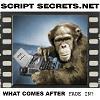BLOCKBUSTERS ON A BUDGET - PART 1
by William C. Martell
I'm writing this column a week before "The Lost World"
kicks off the Summer of no return. Summers used to offer a
smorgasbord of entertainment, but for the past few years studios
have concentrated on big event films. This summer we have a
dozen films with budgets over a hundred million dollars. Though
"Speed" cost just over $20 million to make, the sequel cost $160
million. "Titanic" has broken the "Waterworld" barrier to become
the most expensive film ever made (over $200 million). By the
time you read this, some of these big budget films will already
have flopped. Some studios may end up in serious financial
trouble. Some producers may lose their jobs.
"The Lost World" isn't one of those $100 million films.
Strangely enough, it ended up one of the less expensive summer
films, coming in at only $74 million.
Producers say they have to make the kind of big event films
that audiences want to see. They have to make $100 million
films. But do they?
(2018 note: The average Hollywood film now costs $107 million by the
time it hits your screens., and summer blockbusters can cost $250 million or more.)
For years, low budget producers have been making films which
compete on video with big studio films. High concept
blockbusters without the big budget price tags. Is there
something the big studios can learn from the low budget world?
I'm going to explain how low budget screenwriting techniques
can be used to create blockbuster films on a budget. Producers
can use these screenwriting tricks to make a huge event film for
a third of that $100 million price tag... And I'm including a $20
million star in the price! It all starts with the script.
My example is going to be "Steel Sharks", a budget friendly
techno-thriller script of mine which was produced last year. The
film was shot on a cable TV movie budget and a tight shooting schedule - as an HBO World Premiere Movie.
Our budget was only $3 million, and the goal was to make a Tom Clancey movie for the price of
some standard HBO action flick.
I believe the same film could be shot as a studio film for around
$10-12 million. Add Tom Cruise at $20 million, and you've got a
big blockbuster film for around $32 million.
Before I show you how I did it, here's the trick:
"STEEL SHARKS"
An American chemical weapons scientist (Barry Livingston)
is kidnaped off the street and taken to Iran. CNN reports that
the CIA believes he will be forced to participate in Iran's
chemical weapons program. The clock is ticking.

A Navy SEAL Team is sent in to rescue him. New on the Team
is Bob Rogers (Billy Warlock from "Baywatch") who is our Tom
Cruise-like star. Rogers tangles with the tough second in
command of the SEALS, Lieutenant Cord, played by Tim Abel (star
of Bruckheimer's new "Soldier Of Fortune" TV series).
After the SEAL Team rescues the scientist, they are captured
by the Iranian Army in a HUGE action scene (with the biggest gas
explosion fireball ever put on film!) and taken hostage aboard
one of 3 Iranian submarines. Old Russian Kilo Class diesels.
The American 688 Attack Class sub which was supposed to pick
them up, commanded by Gary Busey, is trapped in the Persian Gulf
by the three subs. He plays a deadly shell game, only able to
fire on 2 of the 3 subs in self defense, as he follows the sub
with the hostages. Lots of large scale underwater submarine
warfare. Lots of torpedoes fired. Lots of countermeasures used.
Things generally explode. The sub battles are bigger than
anything in "Hunt For Red October".
Admiral Tom Perry (Billy Dee Williams) coordinates the
rescue operation from an Aircraft Carrier in the 5th fleet, using
heat registration spy satellites to help Busey evade subs and
keep track of the one our SEAL Team is on.
Williams sends F-14 fighter planes over the Gulf, and will
send choppers to rescue our heroes later. He also gets to call
The Pentagon. We used an actual aircraft carrier, actual Navy
helicopters, and actual F-14s in the film. This IS a big Tom
Clancy style techno-thriller, after all.
While the submarine battle rages outside, inside the Iranian
sub, Billy Warlock and the SEAL Team escape. Now it's "The
Warriors" on a submarine: 5 unarmed men have to travel close to
300 feet, past 100 enemy sailors, to escape. One of the men
(Cord) is wounded, and one is a geeky scientist.
By the end of this film, Iran will lose all 3 submarines (we
explodes 'em!), a bunch of planes flyover, our SEAL Team uses
kitchen chemicals to fight their way through the sub to the
escape trunk (hatch), there's an underwater rescue operation,
helicopters transport our Team to the Carrier, and everyone goes
to 5th Fleet Command in Bahrain to get a medal.
Fade Out
That may sound complicated, but I'm trying to give you an
idea of the scope of the film. It's a mock Tom Clancy techno-
thriller. Billy Warlock is the lead, he gets the character arc
(though other characters also get arcs). Lots of hardware, lots
of REAL F-14s, lots of things get blowed up real good.
Hard to believe a story this big is a cheapie, right? Hard
to believe it cost 1/80th of what "Speed 2" cost. The secret is
in the script.
THE CONCEPT
A staple in action films is the CAR CHASE. We've seen a
million of them, and every new one has to be BIGGER (and more
expensive) than the ones before it. THE ROCK started with the
BULLITT/San Francisco car chase, then began a path of destruction
which included driving the car through a window, over other cars,
knocking a cable car off its tracks and blasting it into the air,
crashing about 20 cars, and blowing up anything which didn't
crash and burn.
Expensive. Because they REALLY had to do the chase. It
couldn't have been done on a computer or in miniature.
One key to a "big budget" film which can be shot cheap is to
come up with BIG ACTION which doesn't have to be done for real.
"ID4" blew up the White House... Done in miniature.
It's also important to keep your actors and effects
separate! Two reasons for this:
1) To combine real actors and miniatures or computer effects is
expensive and time consuming.
2) Real actors make CGI and miniatures look fake. They give us
a point of comparison. This is why Stan Winston built LIFE SIZE
dinosaurs for the petting/touching/standing next to scenes in
"The Lost World". We aren't doing ANYTHING for real!
This DOES limit your palate. You have to find a story where
the big action takes place 'outside' and the actors work
'inside'. "DIE HARD" type movies work well for this. But so
would "ALIEN" and "ALIENS", "CRIMSON TIDE , "EXECUTIVE DECISION",
any Star Trek film, and Hawks version of "THE THING".

My previous HBO World Premiere Movie "Crash Dive" was DIE HARD on a
submarine. A terrorist group takes over a U.S. 688 submarine and
aims nuclear missiles at Washington DC, a retired Navy engineer
sneaks onboard the submarine, using his knowledge of the
submarine to stop the terrorists.
My idea was to have hand to hand fighting and shoot outs
going on Inside the submarine, and a submarine chase and torpedo
exchange going on Outside. The outside stuff was all shot in
miniature (we used one of the models from "Hunt For Red October")
and a three-storey set was built for the Inside stuff.
"Crimson Tide" built their set on a gimble, so that it could
tilt from side to side. On "Crash Dive" we just rented a rocker
device so that the CAMERA could tilt from side to side, and saved
a ton of money. Our three-storey set was designed to be
different parts of the submarine from different angles. Some of
the rooms could be re-dressed as Crew Quarters, Machine Rooms,
the Galley, and the Torpedo Room. The camera could be placed
UNDER the lower deck, so that it could shoot up through the floor
grates and capture all three storeys on film. A terrorist on the
upper floor could shoot down at the hero on the lower floor.
One entire room was built in a tank, so that it could
gradually be filled with water.
The submarine's Control Room was a separate set. That way,
we could film action on the main set at the same time we were
rigging lighting on the Control Room set. Even the set was
designed to ease production and save money.
In the golden age, movies were all shot on sound stages,
with 2nd unit (or stock footage) for exteriors. They made
thousands of great films using this method. I often wonder why
today's producers don't use the cost saving techniques from
yesterday's hit films. Low budget films have been using golden
age studio tricks for years to stretch their budgets.
In "ALIENS" we can show the transport ship leaving the big
space ship and landing on the dusty planet in miniature.
Intercut some cockpit shots showing the actors. Once the
transport ship is at the factory building, we take our actors
inside for the rest of the film, showing the occasional exterior
shot to remind us of the big picture.
The "ALIENS" concept could have been done as a cheapie!
(Corman did an "Aliens" type story for "Carnosaur 2".)
"Steel Sharks" began with the set. They wanted to re-use
that amazing submarine set from "Crash Dive" and asked me to
pitch ideas. I came up with 5 new sub stories, careful to avoid
anything similar to "Crash Dive". Each of the 5 concepts had big
'event movie' action going on outside the submarine, and fast
paced action inside the submarine. After a misfire, the story
chosen was "The Warriors" on a submarine, and it went to script.
In "Steel Sharks" I could have Gary Busey's 688 Sub involved
in underwater chases, hide and seek, and big battles with the 3
enemy Diesel subs because it was all shot in miniature. We could
blow up all 3 enemy subs, because we only had to blow up MODEL
subs, not the real thing. Busey can give the order to fire
torpedoes, then we go to miniature to SEE the torpedoes fire, and
SEE the enemy sub get hit and explode. We can also see the enemy
sub's torpedoes hit the ridge behind Busey's sub, and SEE Busey
and his crew almost knocked off their feet by the concussion.
This is BIG SCALE ACTION... bigger than that car chase from
"The Rock"... but MUCH cheaper to film. I'll bet that car chase
cost more than our entire below the line budget on "Steel
Sharks"! Because their CONCEPT required them to do the big
expensive action scenes FOR REAL... instead of taking advantage
of miniature effects and CGI.
Even though the "Speed" concept required real bus stunts, by
separating the big action from the actors, they kept their budget
reasonable. Keanu and Sandra could be shot driving around on Bus
#1 reacting to obstacles, while a second unit crew could shoot a
stunt driver in Bus #2 actually swerving to avoid (or hitting)
the obstacles. Most of "Speed"s Act 2 is Keanu and Sandra in the
same exact spot on Bus #1 reacting. Very easy to shoot.
But if they would have replaced the real bus with a
miniature submarine, they could have decreased the costs and
increased the production value. Just by changing the Outside
action.
The most important element in bringing budgets down is to
find a concept where the big, expensive action takes place
OUTSIDE (where it can be done with CGI or miniature) and the
actors work INSIDE (on a set built to match the miniature).

Finding a concept for this kind of story is easy. I make a
living doing it, as do many other low budget writers. You start
with the Outside location. My "Moonlight Express" script is
about the hunt for a killer onboard a non-stop express train from
Los Angeles at San Francisco. I used a 727 Chicago to DC shuttle
for "Altitude", the story of passengers who must band together to
fight hijackers. "Black Thunder" uses F-117 stealth fighter
planes (shot in miniature) for the big action scenes in Act 1
(where a top secret plane is stolen) and Act 3 (where our hero
steals the plane back and is chased) to augment the sneaking
behind enemy lines "traditional" action in Act 2 which was filmed
in the desert.
Other good Outside locations include boats, space stations,
under water labs, tunnels, space ships, trains, planes,
submarines, subways, monorails, the space shuttle, a mining
colony on Mars, that Stealth ship the Navy isn't talking about,
and dozens of other places where actors on a set can be combined
with big Outside action to create blockbuster movies on a budget.
Not every film can be made this way, but if a third of all
the studio's big summer event films used this method, they could
cut costs without sacrificing the scope or entertainment value of
their blockbusters. They could make a $100 million film for $32
million, and make more profit if the film was a hit. Event films
in this budget range are guaranteed to make a profit. Last year
the average studio film made $35 million domestic. Unfortunately,
it cost $78 million to make and market.
By using these simple techniques, plus a pair of writing
techniques I'll discuss in the next issue, studios can give the
audience the films they crave, give name actors the $20 million
they demand, and spend a third of the cost of this summer's big
event films.
...FADE OUT
BRAND NEW
OUTLINES & THE THEMATIC!
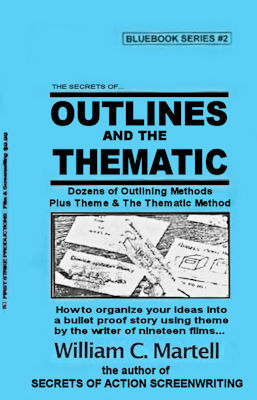
OUTLINES & THE THEMATIC Blue Book.
ARE YOUR SCENES IN THE RIGHT ORDER?
AND ARE THEY THE RIGHT SCENES?
Your story is like a road trip... but where are you going? What's the best route to get there? What are the best sights to see along the way? Just as you plan a vacation instead of just jump in the car and start driving, it's a good idea to plan your story. An artist does sketches before breaking out the oils, so why shouldn't a writer do the same? This Blue Book looks at various outlining methods used by professional screenwriters like Wesley Strick, Paul Schrader, John August, and others... as well as a guest chapter on novel outlines. Plus a whole section on the Thematic Method of generating scenes and characters and other elements that will be part of your outline. The three stages of writing are: Pre-writing, Writing, and Rewriting... this book looks at that first stage and how to use it to improve your screenplays and novels.
Only $4.99!
ALSO NEW!
DESCRIPTION & VOICE Blue Book!
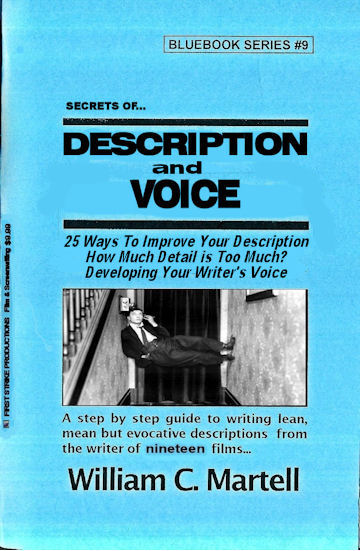
DESCRIPTION & VOICE Blue Book.
IS HALF OF YOUR STORY IN TROUBLE?
Most screenplays are about a 50/50 split between dialogue and description - which means your description is just as important as your dialogue. It just gets less press because the audience never sees it, the same reason why screenwriters get less press than movie stars. But your story will never get to the audience until readers and development executives read your script... so it is a very important factor. Until the movie is made the screenplay is the movie and must be just as exciting as the movie. So how do you make your screenplay exciting to read? Description is important in a novel as well, and the “audience” does read it... how do we write riveting description?
Only $4.99!
Tips FAQ

My New Script Secrets Newsletter!

NEW BOOKS!
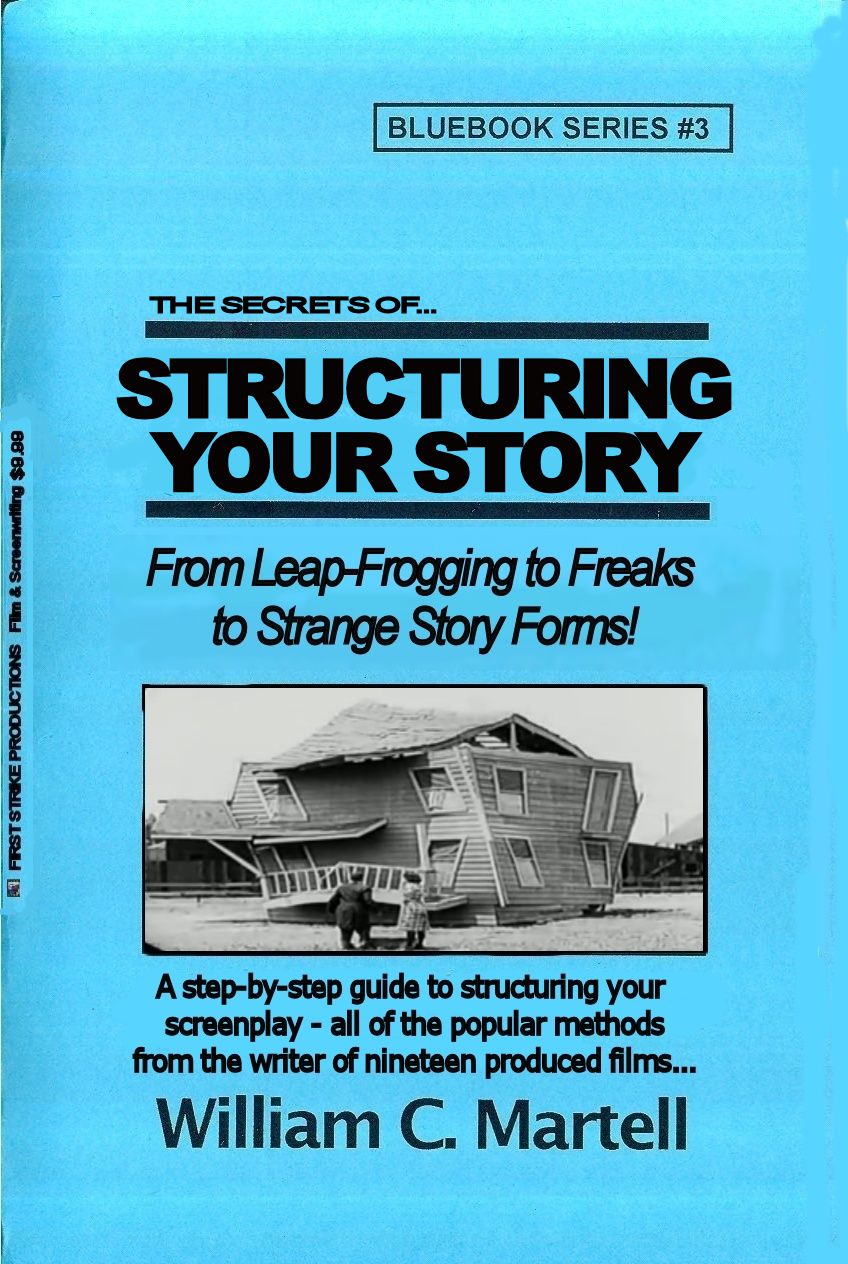
NEW AND HOT!
*** STRUCTURING YOUR STORY *** - For Kindle!
William Goldman says the most important single element of any screenplay is structure. It’s the skeleton under the flesh and blood of your story. Without it, you have a spineless, formless, mess... a slug! How do you make sure your structure is strong enough to support your story? How do you prevent your story from becoming a slug? This Blue Book explores different types of popular structures from the basic three act structure to more obscure methods like leap-frogging. We also look at structure as a verb as well as a noun, and techniques for structuring your story for maximum emotional impact. Most of the other books just look at *structure* and ignore the art of *structuring* your story. Techniques to make your story a page turner... instead of a slug!
Only $4.99 - and no postage!
NO KINDLE REQUIRED! Get the *free* app (any device, except your Mr. Coffee) on the order page on Amazon!
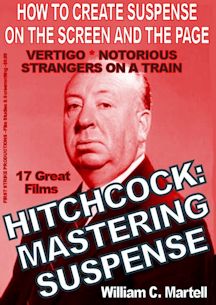
LEARN SUSPENSE FROM THE MASTER!
*** HITCHCOCK: MASTERING SUSPENSE *** - For Kindle!
Alfred Hitchcock, who directed 52 movies, was known as the *Master Of Suspense*; but what exactly is suspense and how can *we* master it? How does suspense work? How can *we* create “Hitchcockian” suspense scenes in our screenplays, novels, stories and films?
This book uses seventeen of Hitchcock’s films to show the difference between suspense and surprise, how to use “focus objects” to create suspense, the 20 iconic suspense scenes and situations, how plot twists work, using secrets for suspense, how to use Dread (the cousin of suspense) in horror stories, and dozens of other amazing storytelling lessons. From classics like “Strangers On A Train” and “The Birds” and “Vertigo” and “To Catch A Thief” to older films from the British period like “The 39 Steps” and “The Man Who Knew Too Much” to his hits from the silent era like “The Lodger” (about Jack The Ripper), we’ll look at all of the techniques to create suspense!
Only $5.99

BRAND NEW!
*** THE BOURNE MOVIES
All five "Bourne" movies (including "Legacy" and it's potential sequels) - what are the techniques used to keep the characters and scenes exciting and involving? Reinventing the thriller genre...
or following the "formula"? Five films - each with an interesting experiment! A detailed analysis of each
of the films, the way these thrillers work... as well as a complete list of box office and critical
statistics for each film. This book is great for writers, directors, and just fans of the series.
Only $3.99 - and no postage!

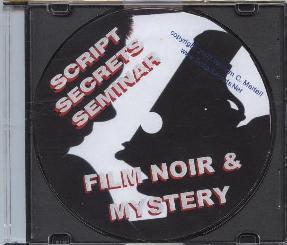
AUDIO CLASS!
NOIR & MYSTERY80 minute CD packed with information on writing Film Noir and Mystery scripts. Using examples from CHINATOWN to OUT OF THE PAST to DOUBLE INDEMNITY you'll learn how to create stories in this dark, twisted genre. How to plant clues, red herrings, suspects, victims, spider women, fallen heroes, the funhouse mirror world of noir supporting characters... and the origins of Film Noir in literature Noir dialogue and how noir endings are different than any other genre. All of the critical elements necessary to write in this critically popular genre.
The Noir & Mystery Class is only $15 (plus $5 S&H). First 20 on Limited Black Disk!
RECESSION SALE! $5 OFF!
IDEAS AND CREATIVITY - 80 minute CD packed with information. Tools to find ideas that are both personal *and* commercial. Hollywood wants scripts with High Concept stories... but not stupid scripts. Developing *intelligent* high concept ideas. How to turn your personal story into a blockbuster - or find your personal story in a high concept idea. Brainstorming and being creative. Ideas and Creativity is $10.00 (plus $5 S&H)
WRITING INDIES - Writing an Indie film? This class covers everything you need to know - from Central Locations to Confined Cameos. Using examples from SWINGERS, THE COOLER, STATION AGENT and others, this 80 minute CD is packed with information. How Indoe films challenge the audience (while mainstream films reassure the audience). Structures, using BOYS DON'T CRY, RUN LOLA RUN, HILARY & JACKIE, and others as example. Writing for a budget, writing for non-actors, getting the most production value out of your budget. Writing Indies is $10.00 (plus $5 S&H)
WRITING HORROR - The essentials of a horror screenplay - what do ROSEMARY'S BABY, NIGHT OF THE LIVING DEAD, THE EXORCIST, BRIDE OF FRANKENSTEIN, THE OTHERS and OPEN WATER have in common? This class will tell you! All of the critical elements necessary to write a script that scares the pants off the audience. Writing Horror is $10.00 (plus $5 S&H).
Click here for more information on CLASS CDs!
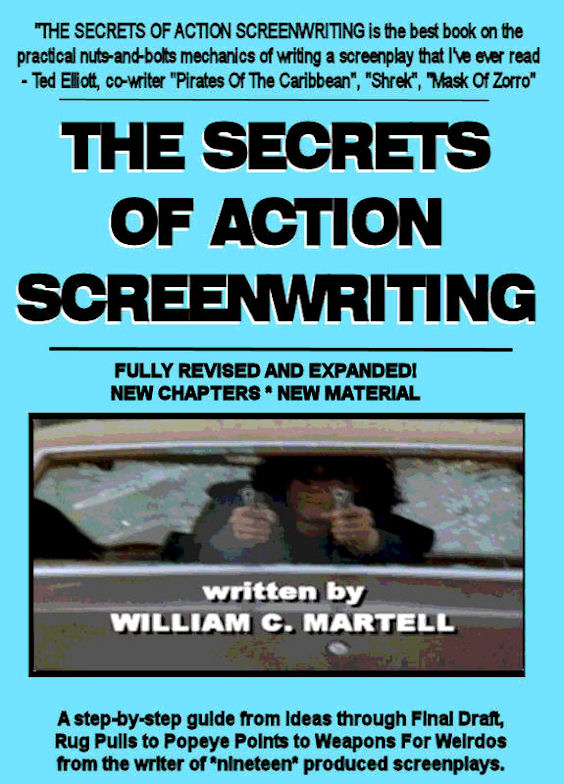
THE BOOK THAT STARTED IT ALL!
*** THE SECRETS OF ACTION SCREENWRITING *** - For Kindle!
*** THE SECRETS OF ACTION SCREENWRITING *** - For Nook!
Why pay $510 for a used version of the 240 page 2000 version that used to retail for $21.95? (check it out!) when
you can get the NEW EXPANDED VERSION - over 500 pages - for just $9.99? New chapters, New examples, New techniques!
"SECRETS OF ACTION SCREENWRITING is the
best book on the practical nuts-and-bolts mechanics of writing a screenplay I've ever read."
- Ted Elliott, co-writer of MASK OF ZORRO, SHREK, PIRATES OF THE CARIBBEAN and the sequels (with Terry Rossio). (ie; 4 of the top 20 Box Office Hits Of ALL TIME.)
Only $9.99 - and no postage!
READY TO BREAK IN?
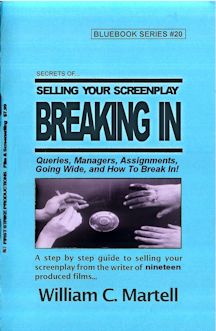
NEW!
*** BREAKING IN BLUE BOOK *** - For Kindle!
Should really be called the BUSINESS BLUE BOOK because it covers almost everything you will need to
know for your screenwriting career: from thinking like a producer and learning to speak their language,
to query letters and finding a manager or agent, to making connections (at home and in Hollywood) and
networking, to the different kinds of meetings you are will have at Studios, to the difference between
a producer and a studio, to landing an assignment at that meeting and what is required of you when you
are working under contract, to contracts and options and lawyers and... when to run from a deal!
Information you can use *now* to move your career forward! It's all here in the Biggest Blue Book yet!
Print version was 48 pages, Kindle version is over 400 pages!
$4.99 - and no postage!
NO KINDLE REQUIRED! Get the *free* app (any device, except your Mr. Coffee) on the order page on Amazon!

STORY: WELL TOLD!
*** STORY: WELL TOLD *** - For Kindle!
This book takes you step-by-step through the construction of a story... and how to tell a story well, why Story always starts with character... but ISN'T character, Breaking Your Story, Irony, Planting Information, Evolving Story, Leaving No Dramatic Stone Unturned, The Three Greek Unities, The Importance Of Stakes, The Thematic Method, and how to create personal stories with blockbuster potential. Ready to tell a story?
Print version was 48 pages, Kindle version is over 85,000 words - 251 pages!
Only $4.99 - and no postage!
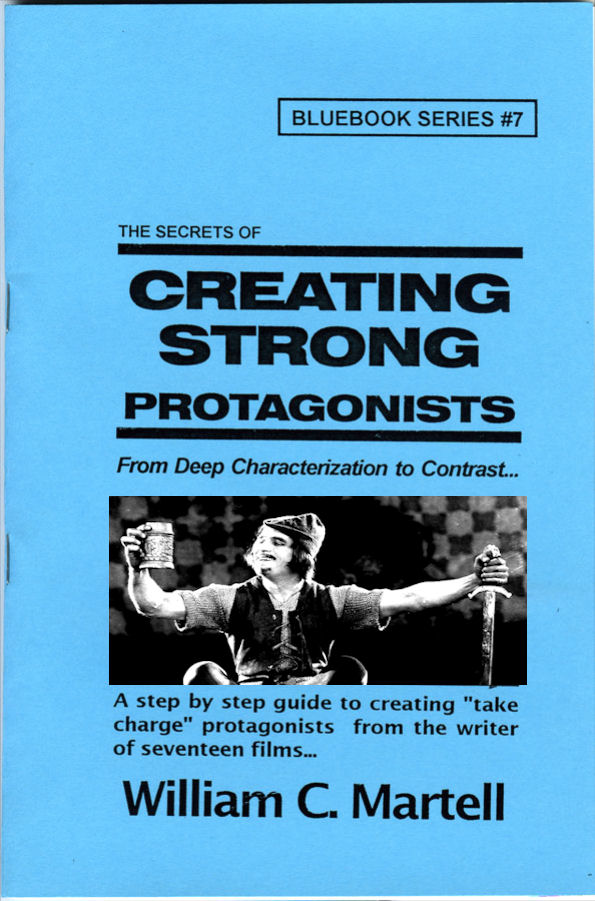
MOVIES ARE CHARACTERS!
*** CREATING STRONG PROTAGONISTS *** - For Kindle!
*** CREATING STRONG PROTAGONISTS *** - For Nook!
Expanded version with more ways to create interesting protagonists! A step-by-step guide to creating "take charge" protagonists. Screenplays are about characters in conflict... characters in emotional turmoil... Strong three dimensional protagonists who can find solutions to their problems in 110 pages. But how do you create characters like this? How do you turn words into flesh and blood? Character issues, Knowing Who Is The Boss, Tapping into YOUR fears, The Naked Character, Pulp Friction, Man With A Plan, Character Arcs, Avoiding Cliche People, Deep Characterization, Problem Protagonists, 12 Ways To Create Likable Protagonists (even if they are criminals), Active vs. Reactive, The Third Dimension In Character, Relationships, Ensemble Scripts, and much, much more. Print version is 48 pages, Kindle version is once again around 205 pages!
ONLY $4.99 - and no postage!
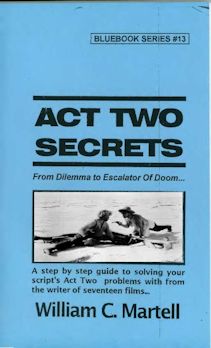
ACT TWO SOLUTIONS!
*** ACT TWO SECRETS *** - For Kindle!
Expanded version with more techniques to help you through the desert of Act Two! Subjects Include: What Is Act Two? Inside Moves, The 2 Ps: Purpose & Pacing, The 4Ds: Dilemma, Denial, Drama and Decision, Momentum, the Two Act Twos, Subplot Prisms, Deadlines, Drive, Levels Of Conflict, Escalation, When Act Two Begins and When Act Two Ends, Scene Order, Bite Sized Pieces, Common Act Two Issues, Plot Devices For Act Two, and dozens of others. Over 67,000 words (that’s well over 200 pages) of tools and techniques to get you through the desert of Act Two alive!
Print version was 48 pages, Kindle version is well over 200 pages!
ONLY $4.99 - and no postage!
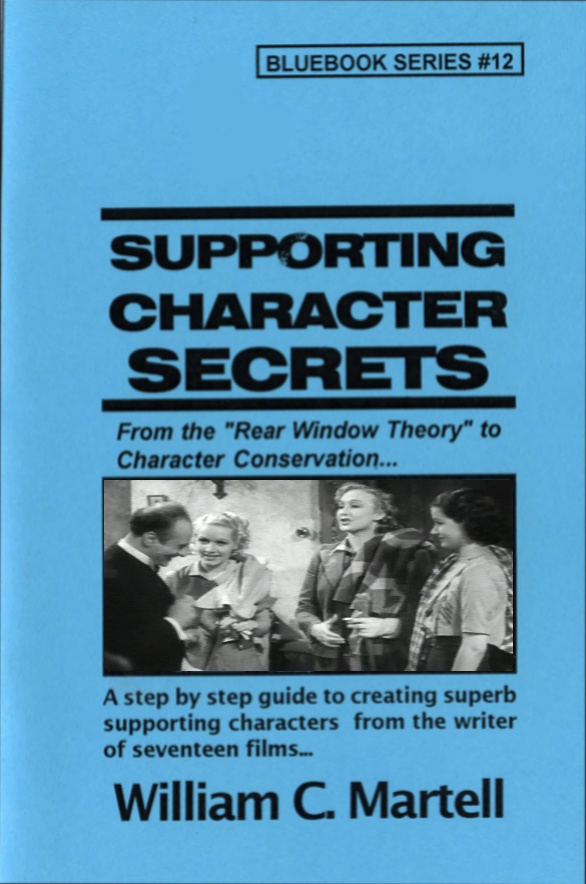
SUBPLOTS?
*** SUPPORTING CHARACTER SECRETS *** - For Kindle! (Exclusive)
Expanded version with more techniques to flesh out your Supporting Characters and make them individuals. Using the hit movie BRIDESMAIDS as well as other comedies like THE HANGOVER and TED and HIGH FIDELITY and
40 YEAR OLD VIRGIN and many other examples we look at ways to make your Supporting Characters come alive on the page.
Print version was 48 pages, Kindle version is around 170 pages!
ONLY $4.99 - and no postage!
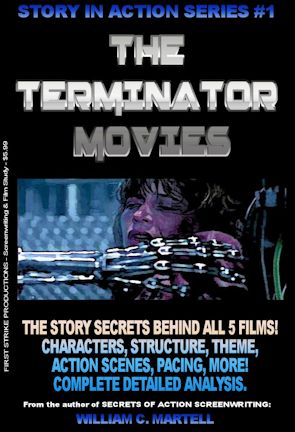
Over 240 pages!
*** THE TERMINATOR MOVIES *** - For Kindle!
He's back! The release of "Terminator: Genisys" (now on BluRay) is set to begin a new trilogy in
the Terminator story... 31 years after the first film was released. What draws us to these films about
a cybernetic organism from the future sent back in time? Why is there a new proposed trilogy every few
years? This book looks at all five Terminator movies from a story standpoint - what makes them work
(or not)? What are the techniques used to keep the characters and scenes exciting and involving? How
about those secret story details you may not have noticed? Containing a detailed analysis of each of
the five films so far, this book delves into the way these stories work... as well as a complete list of
box office and critical statistics for each film. This book is great for writers, directors, and just
fans of the series.
ONLY $3.99 - and no postage!

ADVICE FROM 1920!
*** VINTAGE #1: HOW TO WRITE PHOTOPLAYS *** - For Kindle!
***
Screenwriting books have been around as long as films have. This series reprints vintage screenwriting books with a new introduction and history, plus new articles which look at how these lessons from almost 100 years ago apply to today’s screenplays. Anita Loos book is filled with information which still applies.
In addition to the full text of the original book, you get the full screenplay to Miss Loos' hit THE LOVE EXPERT, plus several new articles on the time period and women in Hollywood.
ONLY $2.99 - and no postage!
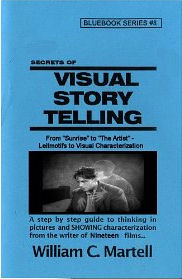
I WRITE PICTURES!
*** VISUAL STORYTELLING *** - For Kindle! (exclusive)
Show Don't Tell - but *how* do you do that? Here are techniques to tell stories visually! Using Oscar Winning Films and Oscar Nominated Films as our primary examples: from the first Best Picture Winner "Sunrise" (1927) to the Oscar Nominated "The Artist" (which takes place in 1927) with stops along the way Pixar's "Up" and Best Original Screenplay Winner "Breaking Away" (a small indie style drama - told visually) as well as "Witness" and other Oscar Winners as examples... plus RISE OF THE PLANET OF THE APES. Print version is 48 pages, Kindle version is over 200 pages!
ONLY $4.99 - and no postage!
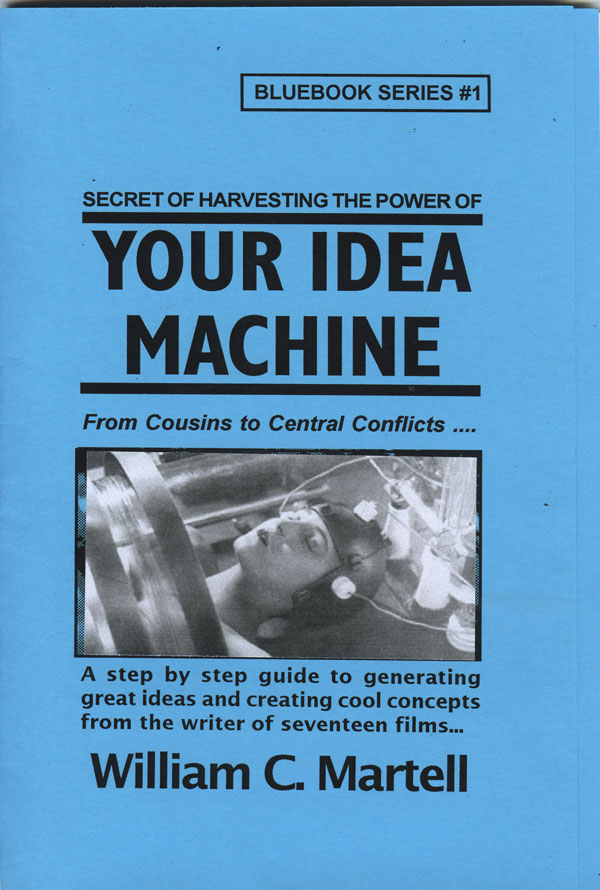
BEST SELLER!
*** YOUR IDEA MACHINE *** - For Kindle!
*** YOUR IDEA MACHINE *** - For Nook!
Expanded version with more ways to find great ideas! Your screenplay is going to begin with an idea. There are good ideas and bad ideas and commercial ideas and personal ideas. But where do you find ideas in the first place? This handbook explores different methods for finding or generating ideas, and combining those ideas into concepts that sell. The Idea Bank, Fifteen Places To Find Ideas, Good Ideas And Bad Ideas, Ideas From Locations And Elements, Keeping Track Of Your Ideas, Idea Theft - What Can You Do? Weird Ways To Connect Ideas, Combing Ideas To Create Concepts, High Concepts - What Are They? Creating The Killer Concept, Substitution - Lion Tamers & Hitmen, Creating Blockbuster Concepts, Magnification And The Matrix, Conflict Within Concept, Concepts With Visual Conflict, Avoiding Episodic Concepts, much more! Print version is 48 pages, Kindle version is over 175 pages!
Only $4.99 - and no postage!

PRO DIALOGUE TECHNIQUES!
*** DIALOGUE SECRETS *** - For Kindle!
*** DIALOGUE SECRETS *** - For Nook!
Expanded version with more ways to create interesting dialogue! How to remove bad dialogue (and what *is* bad dialogue), First Hand Dialogue, Awful Exposition, Realism, 50 Professional Dialogue Techniques you can use *today*, Subtext, Subtitles, Humor, Sizzling Banter, *Anti-Dialogue*, Speeches, and more. Tools you can use to make your dialogue sizzle! Special sections that use dialogue examples from movies as diverse as "Bringing Up Baby", "Psycho", "Double Indemnity", "Notorious", the Oscar nominated "You Can Count On Me", "His Girl Friday", and many more! Print version is 48 pages, Kindle version is over 175 pages!
Only $4.99 - and no postage!

Use your creative energy to focus on the content; let Final Draft take care of the style. Final Draft is the number-one selling application specifically designed for writing movie scripts, television episodics and stage plays. Its ease-of-use and time-saving features have attracted writers for almost two decades positioning Final Draft as the Professional Screenwriters Choice. Final Draft power users include Academy, Emmy and BAFTA award winning writers like Oliver Stone, Tom Hanks, Alan Ball, J.J. Abrams, James Cameron and more.
* * * Buy It!
